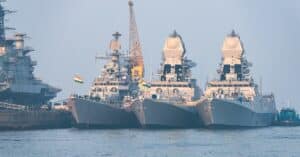
Indian Navy All Set to Commission Its Latest Survey Vessel, Sandhayak
February 2, 2024
Indian Navy Rescues Ship With Iranian and Pakistani Crew From Pirates Off Somali Coast
February 3, 2024
For many years, India’s defence policy focussed on its land borders with China and Pakistan. However, it is starting to flex its vast naval capabilities in international waters through anti-piracy patrols and deployments in the Red Sea to help protect ships from Houthi attacks.

India deployed 3 guided missile destroyers and reconnaissance aircraft when Houthis began to target ships, causing disruptions in the vital shipping lane that handles 12% of world trade.
These deployments show that India is a proactive contributor to international maritime stability, said Vice Adm. Anil Kumar Chawla, who retired as head of India’s southern naval command in 2021.
India is publicising these deployments and has expressed its desire to assume greater responsibilities in ensuring greater maritime security. It has expanded its maritime ambitions in the face of Chinese naval presence.
The Indian Navy has helped 4 ships, 3 of which were targeted by Houthis and another which Washington blamed on Iran.
On January 26, Destroyer INS Visakhapatnam helped the crew of a Marshall Islands-flagged tanker to fight a fire after it was struck by a missile in the Gulf of Aden. Around 10 days earlier, the Visakhapatnam responded to a distress call by Genco Piacrdy merchant vessel after a drone attack.
Darshana M. Baruah, a fellow at the Carnegie Endowment for International Peace, said that Maritime security has not been a strong pillar of Indian Foreign Policy Engagements in a way that we are starting to see now.
China has built a considerable presence in the Indian Ocean over the years as it is a major route for its energy supplies. It has the largest navy in the world by the number of ships, more than three times the size of the Indian Navy.
China also has a strong fleet of Coast Guard ships, a maritime militia comprising fishing vessels that work with the Coast Guard in asserting its territorial claims, especially in the South China Sea.
It continues to expand its presence by establishing infrastructure deals with India’s neighbouring nations like Bangladesh, Sri Lanka and Maldives.
The Chinese are trying to establish more naval bases in the Indian Ocean. Experts say the growing Chinese threat has pushed India to acquire more advanced ships, aircraft, and submarines and invest more in infrastructure and technology.
India has expanded its maritime role and is forging strategic relationships through joint exercises with friendly nations in the region and beyond.
However, the South China Sea remains the most critical concern since 60% of India’s cargo passes through shipping routes in the China-dominated region.
References: Jakartaglobe, AP News
India Assumes Greater Maritime Role To Face China In the Indian Ocean & South China Sea appeared first on Marine Insight – The Maritime Industry Guide
Source: Maritime Shipping News


